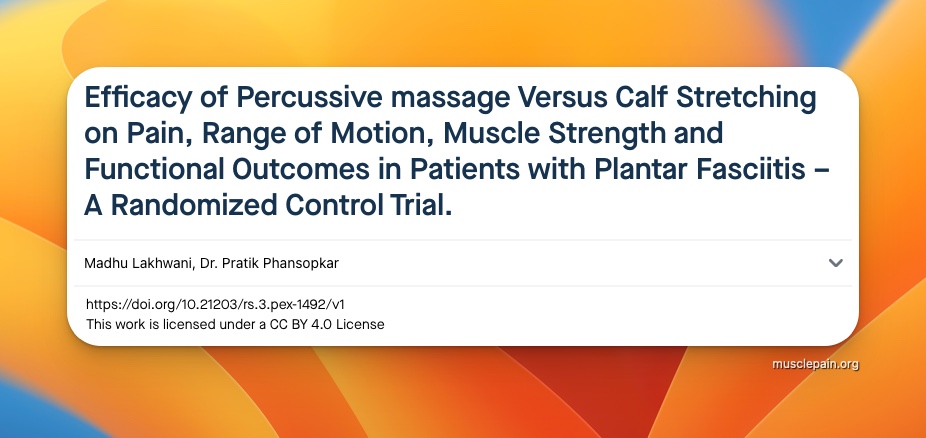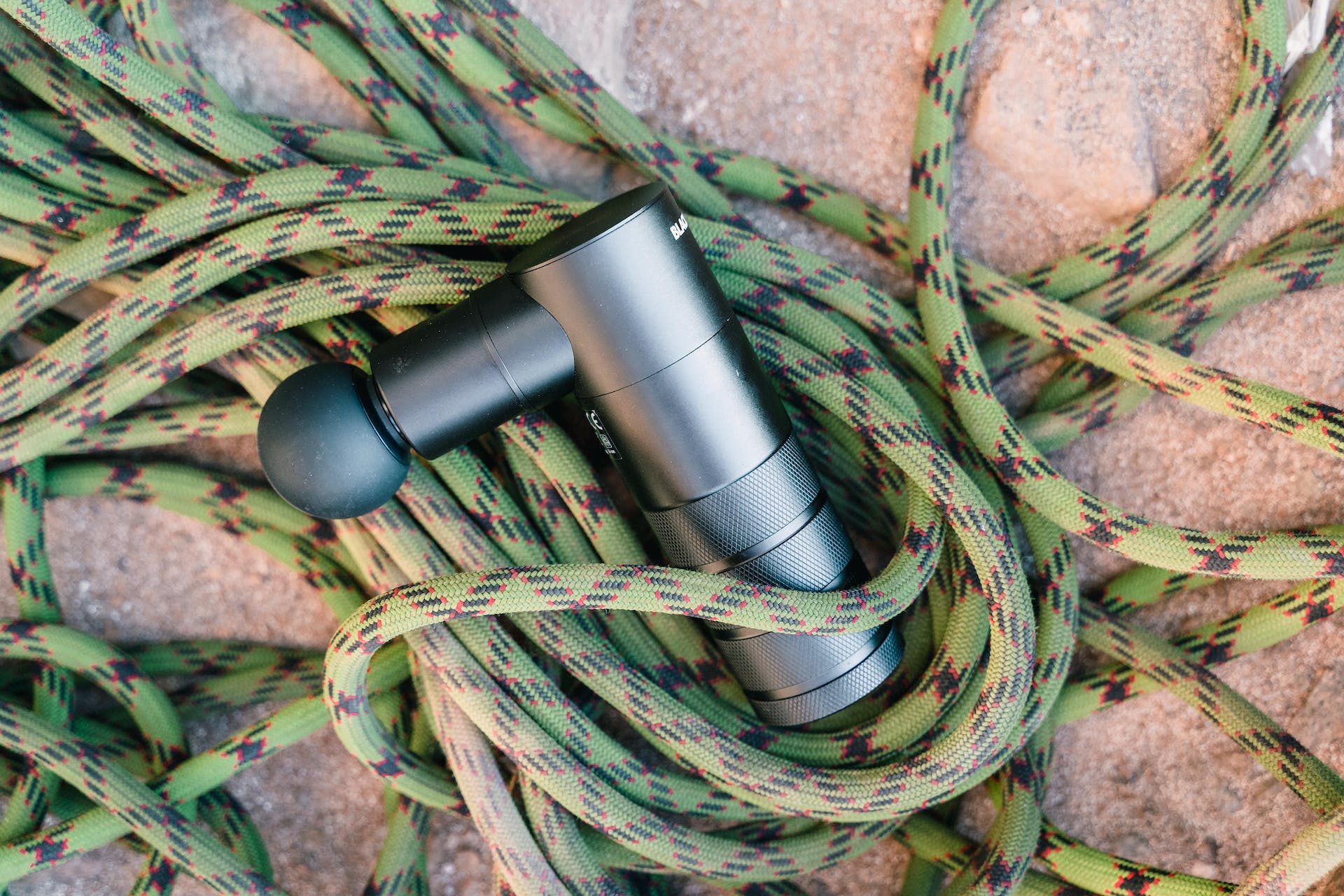Plantar fasciitis is a common condition characterized by inflammation and pain in the plantar fascia, a thick band of tissue that runs along the bottom of the foot. It is often caused by repetitive strain or excessive stress on the foot, such as running, walking, or standing for long periods.
Massage guns, also known as percussion massagers or handheld massagers, have gained popularity in recent years as a tool for muscle recovery and pain relief.
These devices use rapid, repetitive strokes to target specific areas of the body, providing deep tissue massage and increasing blood flow to the affected area.
The pain relief provided by massage guns is multifaceted, involving mechanotransduction, molecular pathway activation, muscle and nervous system modulation, and direct effects on muscle tension and pain perception.
How do Massage Guns work?
- Mechanotransduction and Immunomodulation: Massage therapies, including the use of massage guns, may influence the inflammatory process and nerve sensitization by altering signaling pathways. This process, known as mechanotransduction, involves the conversion of mechanical stimulation into cellular activity, potentially leading to decreased secondary injury and pain relief (Waters-Banker et al., 2014).
- Activation of Specific Molecular Pathways: Research has shown that massage can activate molecular pathways responsive to mechanical stress. This includes the activation of signaling pathways such as focal adhesion kinase (FAK) and extracellular signal-regulated kinases (ERK1/2), which are involved in cellular responses to mechanical stimuli. This activation can lead to the formation of new mitochondria in muscle cells, enhancing recovery from muscle damage. Additionally, massage has been found to mitigate the rise in nuclear factor κB (NFκB), an inflammatory mediator, thereby reducing cellular stress and inflammation (Crane et al., 2012).
- Influence on Muscle and Nervous System: Massage therapy, including the use of massage guns, can induce changes in muscle tissue and the nervous system. It may modulate inflammatory responses in muscles and alleviate muscle atrophy, especially following immobilization. The pressure and vibration from a massage gun may generate waves that influence muscle tissue at a cellular level, affecting both the muscle and the nervous system (Sakitani et al., 2019).
- Pain Relief and Muscle Relaxation: The application of massage therapy can lead to pain relief and muscle relaxation. This is achieved through direct mechanical action on the muscles, helping to relieve tension and spasms. The stimulation of pressure receptors during massage therapy is thought to increase vagal activity and decrease stress hormone levels, particularly cortisol, which contributes to pain relief and muscle relaxation (Field, 1998).
How can they help with Plantar Fasciitis pain?
When it comes to plantar fasciitis, massage guns can be beneficial in several ways:
- Pain Relief: Massage guns can help alleviate the pain associated with plantar fasciitis by reducing muscle tension and promoting relaxation. The deep tissue massage provided by these devices can help release tightness in the muscles and fascia, providing temporary relief from discomfort.
- Improved Circulation: By increasing blood flow to the affected area, massage guns can help promote healing and reduce inflammation. The enhanced circulation can bring essential nutrients and oxygen to the affected tissues, aiding in the recovery process.
- Breaking Up Scar Tissue: Plantar fasciitis can lead to the formation of scar tissue in the plantar fascia, which can further contribute to pain and limited mobility. Massage guns can help break down this scar tissue, promoting flexibility and restoring normal function to the foot.
- Relaxation and Stress Reduction: Plantar fasciitis can be a frustrating and debilitating condition, causing stress and discomfort. The use of massage guns can provide a soothing and calming effect, helping individuals relax and unwind while also addressing the physical pain.
What does Clinical Evidence say?

- Percussive Massage vs. Calf Stretching: A randomized control trial compared percussive massage therapy (using devices like Theragun) with calf stretching in patients with plantar fasciitis. The study focused on the impact of percussive massage on pain, range of motion, muscle strength, and functional outcomes (Lakhwani & Phansopkar, 2021).
- Deep Friction Massage: Another study evaluated the efficacy of deep friction massage compared to local steroid injection for plantar fasciitis treatment. It found that deep friction massage was less effective than steroid injections for improving pain and function (Moshrif, Elwan, & Daifullah, 2020).
- Positive Reaction Point Massage: Research on the clinical effects of positive reaction point massage in treating plantar fasciitis showed that this technique could be effective in alleviating pain and discomfort (Zhao Yu, 2012).
- Transverse Frictional Massage: A comparative study on the effectiveness of Muscle Energy Techniques (MET) and Cyriax (Transverse Frictional Massage) indicated that Cyriax, combined with self-stretching, was more effective for pain and function in chronic plantar fasciitis patients (Kulkarni, Honkalas, & Golhar, 2020).
Are there any risks associated with using a massage gun for plantar fasciitis?
Yes, there are some risks associated with using a massage gun for plantar fasciitis. Overusing the device or applying too much pressure can cause tissue damage, bruising, and nerve damage.
Additionally, using a massage gun on an area that is already inflamed or irritated can worsen the condition. Therefore, it is essential to use caution when using a massage gun and to follow the instructions provided by the manufacturer.
Are there any precautions to take when using a massage gun for plantar fasciitis?
When using a massage gun for plantar fasciitis, it is important to take certain precautions to ensure safe and effective treatment. Here are some key precautions to consider:
- Avoid massaging over bony areas: It is important to avoid massaging over bony areas such as the heel or toes, as this can irritate the sensitive areas and worsen the condition.
- Avoid overusing the device or applying too much pressure: Overusing the massage gun or applying excessive pressure can lead to further inflammation and pain. It is recommended to use the device in short bursts and with light pressure.
- Start with low intensity and short duration: When using the massage gun on the feet, begin with the lowest setting and use it for a short duration, such as one minute on each foot, to assess how it feels and avoid increasing inflammation.
Important:
However, it is important to note that while massage guns can be a helpful addition to a comprehensive treatment plan for plantar fasciitis, they should not be relied upon as the sole treatment method.
It is crucial to consult with a healthcare professional, such as a physical therapist or podiatrist, who can provide a personalized treatment plan that may include stretching exercises, orthotic devices, and other therapies.
References
- Lakhwani, M., & Phansopkar, P. (2021). Efficacy of Percussive Massage Versus Calf Stretching on Pain, Range of Motion, Muscle Strength, and Functional Outcomes in Patients with Plantar Fasciitis – A Randomized Control Trial.
- Moshrif, A., Elwan, M., & Daifullah, O. S. (2020). Deep Friction Massage versus Local Steroid Injection for Treatment of Plantar Fasciitis: A Randomized Controlled Trial. Egyptian Rheumatology and Rehabilitation.
- Yu, Z. (2012). Clinical Observation of Treating Plantar Fasciitis through Positive Reaction Point Massage. West China Medical Journal.
- Kulkarni, S. G. S., Honkalas, P., & Golhar, S. (2020). Effectiveness of MET and Cyriax (Transverse Frictional Massage) on Pain and Function in Patients with Chronic Plantar Fasciitis: A Comparative Study. International Journal of Applied Research.
- Waters-Banker, C., Dupont-Versteegden, E., Kitzman, P., & Butterfield, T. (2014). Investigating the mechanisms of massage efficacy: the role of mechanical immunomodulation. Journal of Athletic Training, 49(2), 266-273.
- Crane, J., Ogborn, D., Cupido, C., Melov, S., Hubbard, A., Bourgeois, J., & Tarnopolsky, M. (2012). Massage Therapy Attenuates Inflammatory Signaling After Exercise-Induced Muscle Damage. Science Translational Medicine, 4(119), 119ra13.
- Sakitani, N., Maekawa, T., Saitou, K., Suzuki, K., Murase, S., Tokunaga, M., Yoshino, D., Sawada, K., Takashima, A., Nagao, M., Ogata, T., & Sawada, Y. (2019). Application of Consistent Massage-Like Perturbations on Mouse Calves and Monitoring the Resulting Intramuscular Pressure Changes. Journal of Visualized Experiments: JoVE, 151.
- Field, T. (1998). Touch Therapy Effects on Development. International Journal of Behavioral Development, 22, 779-797.

Physiatrist, M.D. Pain Center of University of São Paulo

